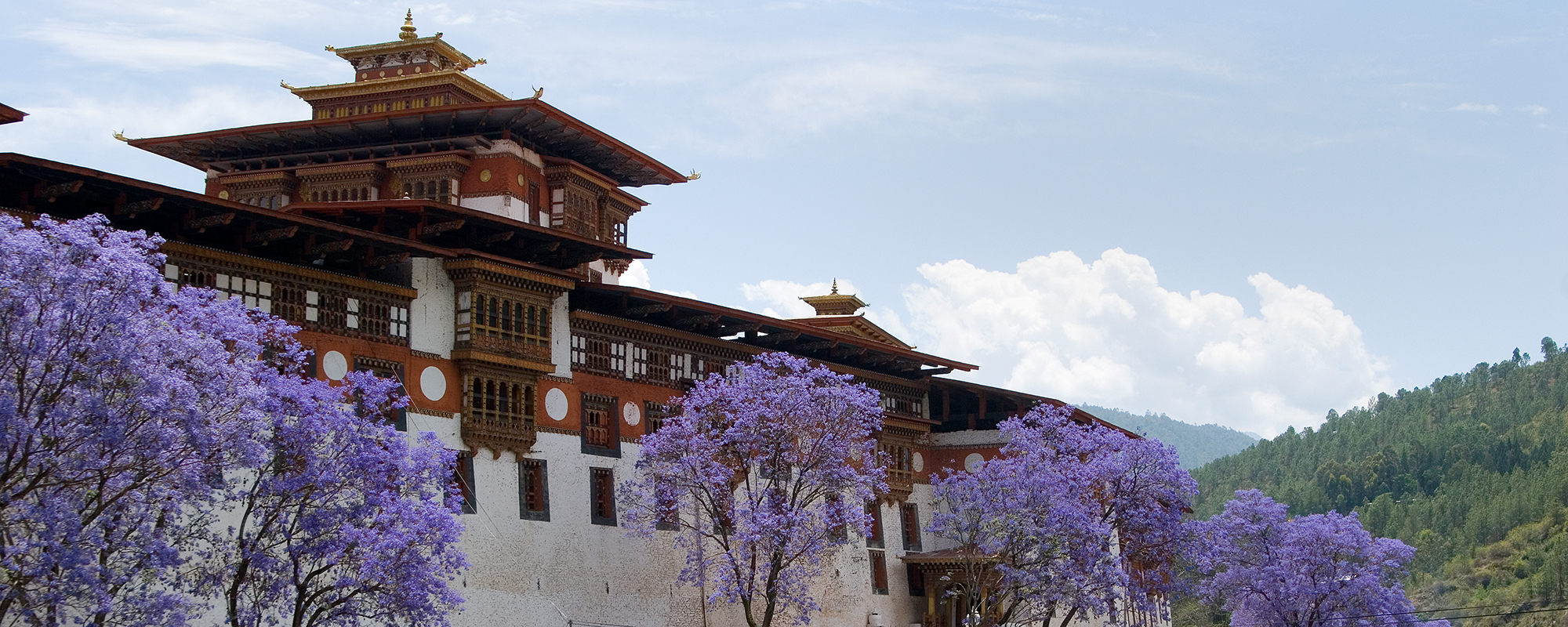
Day 1
In clear weather, Druk Air’s flight to Bhutan provides a wonderful view of Himalayan scenery. Whether flying along the Himalayan range from Kathmandu or over the foothills from Kolkata, it is a breathtaking journey, culminating in an exciting descent past forested hills into the kingdom.
- Pick up from airport by the representative from Dragon Rider Travels.
- Tamchu Lhakhang
It is located along Paro-Thimphu highway, on the base of a mountain across the Pa chu river. It was built in the early 15th century by the great iron bridge builder and Poet-Yogi Thangtong Gyalpo (1385-1464). The temple is privately run by the descendents of Thangtong Gyalpo.
- Lunch at Thimphu
- Visit the Takin Zoo. Takin is the national animal of Bhutan.
- Buddha point
The huge 51m tall steel of Buddha Dordenma commands the entry to the Thimphu valley. The massive three-storey base houses a chapel, while the body itself is filled with 125,000 smaller statues of Buddha. The paved road to the site passes a new hindu temple. The area is also called Changri Kuensel Phodrang.
- Memorial Chorten
The memorial chorten was built in 1974 to honour the 3rd king of Bhutan. It is the most visible landmark in Bhutan; it is patterned on the design of a classical Tibetan stupa, with a pyramidal pillar crowned by a crescent moon and sun. It is decorated with richly carved annexes facing the four directions, and contains mandalas, statues and a shrine dedicated to the third king. The stupa attracts elderly Bhutanese on a daily basis who circumambulate the stupa, whirls the large prayer wheels and prays at the shrine.
- ThimphuDzong
Zhabdrung Ngawang Namgyal built TrashichhoDzong- the fortress of the Glorious religion in 1641. The third king of Bhutan rebuilt the fortress in traditional fashion, without nails or written plans. Today, it houses the Throne Room of the King of Bhutan and the government secretariat. Its northern flank is used as the summer residence of the Chief Abbot and the clergy.
- Night halt in Thimphu.
Day 2
- Dochula Pass
The first stop after leaving Thimphu on the journey east is Dochula pass at 3100mtrs. Only about 45 mins drive from Thimphu, it offers visitors their first glimpse of the Himalayan range. On the pass you can also visit the 108 stupas built by Her Majesty the Queen Mother Ashi Dorji Wangmo Wangchuck in 2008.
- Chimi Lhakhang
It is also known as the temple of fertility, associated with the “Divine Madman” Drukpa Kuenley, who is known for his eccentric teachings and is said to have subdued evil spirits on this spot. He used the phallus as a ‘medium’ to subdue and discipline the malevolent spirits, and also to free up the social inhibitions. The temple was built in 1499.
- Lunch at Punakha
- Punakha Dzong
The Palace of Great Bliss houses the sacred Machen Lhakhang, the sanctum where the relic of Zhabdrung Ngawang Namgyal is preserved. It is from this temple that the Kings of Bhutan receive their blessings and ceremonial scarves for their coronations. Bhutan’s founder Zhanbdrung Ngawang Namgyal according to his own designs built the fortress in 1637. The dzong served as the ancient capital if Bhutan for centuries before it was shifted to Thimphu in the 1950s.
- Return to Thimphu via the same route.
- Night halt in Thimphu.
Day 3
Simply Bhutan
Visit the Simply Bhutan, which is a living museum that gives a good-guided introduction to various aspects of Bhutanese traditional life.
- Weaving Centre
Take a tour of the weaving centre to witness the process of how the fine-looking Bhutanese textiles are made.
- Archery field
Witness the national sport of Bhutan, archery, and a highly popular game played throughout the country. Using bows and arrows, team of archers shoot at targets only 30centimeters in diameter from a distance of 120-130 meters.
- Drive to Paro
- Lunch at Paro
- Museum
At one time a watchtower built to defend the Paro Dzong during inter-valley wars of the 17th century; the Ta Dzong has been functioning as the National Museum since 1967. It holds fascinating collections of art, relics, religious paintings and Bhutan’s exquisite postage stamps.
- Paro Dzong
Also known as the Rinpung Dzong, which literally translates into “fortress of the heap of jewels”. The construction of the dzong began in 1644 upon the order of Zhabdrung Ngawang Namgyal. It now houses the monastic body and also the district offices. - Night halt in Paro.
Day 4
- Takshang Monastery
Also known as “Tigers Nest”, Takshang is Bhutan’s most iconic landmark and religious site. The temple clings impossibly to a precariously sheer cliff 800 meters above the Paro valley at an altitude of 3120m. In order to arrive at the temple visitors must trek for 2-3 hours through beautiful, shady pine forests. No trip to Bhutan is complete without a visit to this remarkable heritage site, which is the most iconic and important historical site.
- Lunch in Paro
- Kyichu Lhakhang
It is one of the 108 temples built by the First Buddhist King Songtsen Gampo in one day across the Himalayan region in the 7th century to pin down the left foot of a giant ogress who was thwarting the establishment of Buddhism in the Himalayas. It is one of the oldest temples built in Bhutan.
- Later in the evening go for a walk in the Paro town.
- Night halt in Paro.
Day 5
We will drop you to the airport and bid you farewell with the hope of seeing you again.